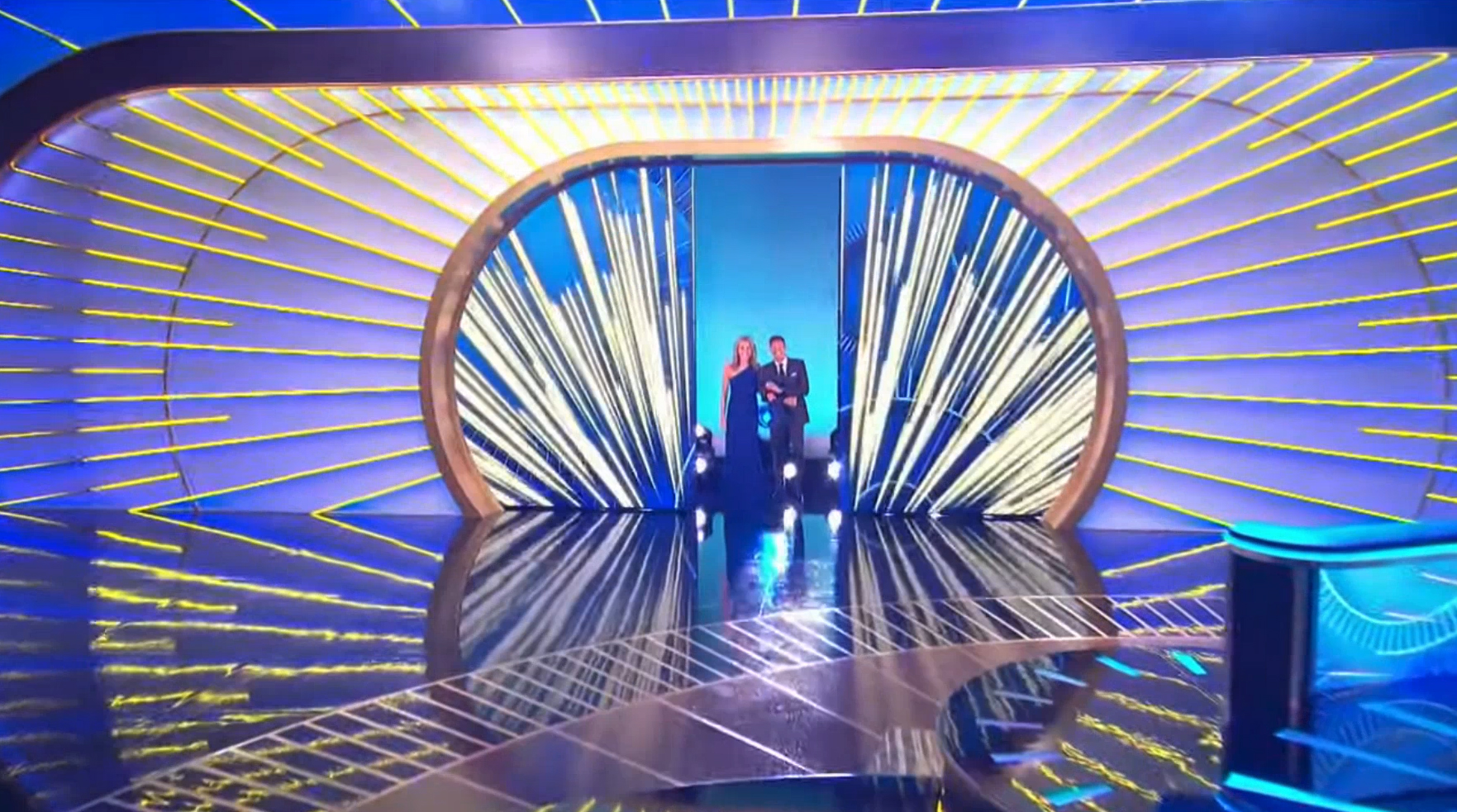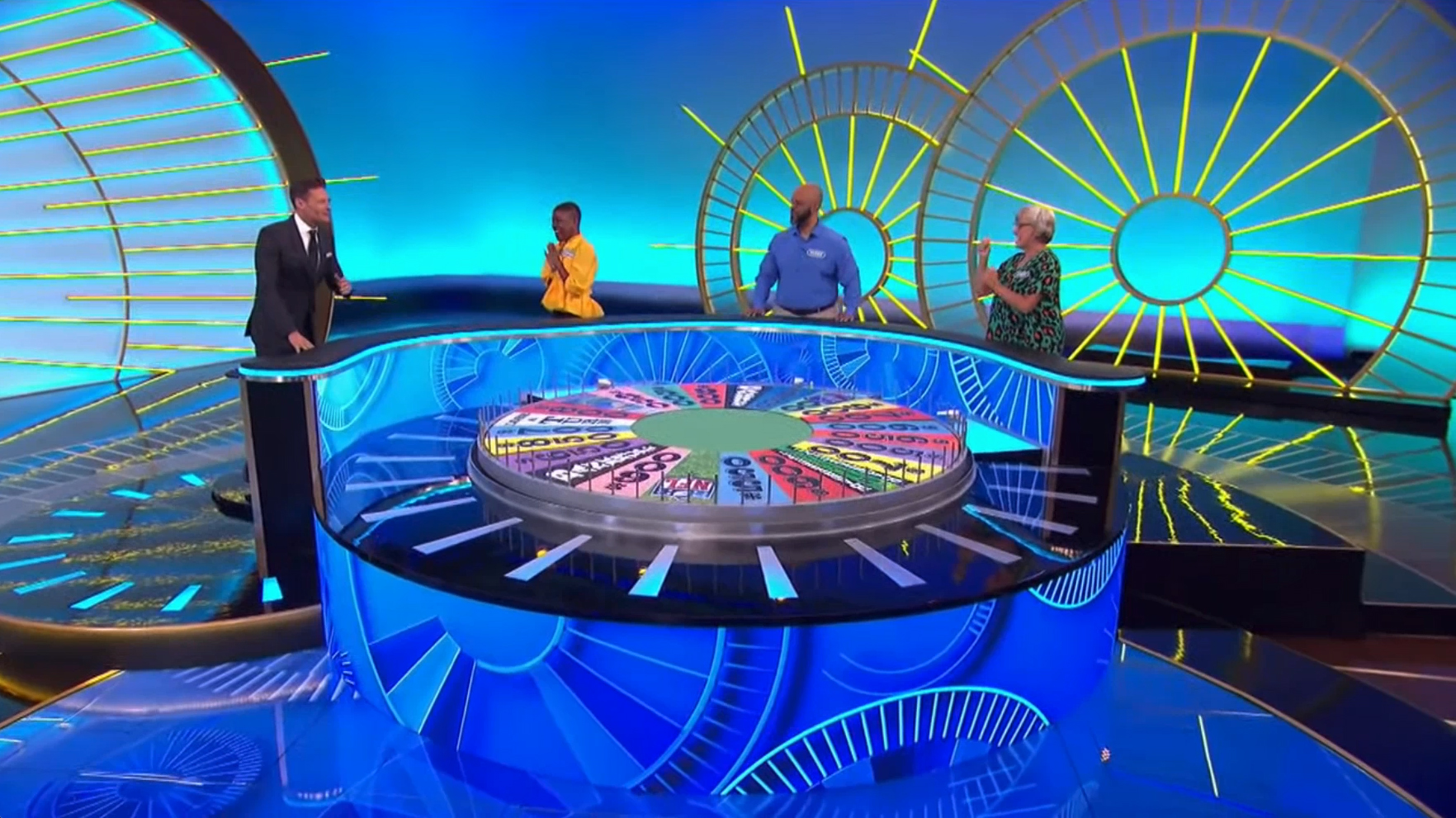‘Wheel of Fortune’ goes full circle with new set inspired by past incarnations

Subscribe to NCS for the latest news, project case studies and product announcements in broadcast technology, creative design and engineering delivered to your inbox.
Along with a n_w host, “Wh_ _l of Fortun_” also d_but_d a n_w look that’s a updat_d spin th_ show’s historic glitzy looks. (If that sentence doesn’t make sense, you’ll need to buy a vowel — give it a whirl.)
To create the classic game show’s updated scenic design, production designer J.P. Connelly was brought on board to round out the show’s in-house production design team, something he describes as a truly unique experience.
“It really is unbelievable to be part of it,” Connelly told NewscastStudio, noting he worked closely with production designer Renee Hoss-Johnson, who joined the show under its original design team.
Just the words “Wheel of Fortune” conjures up memories for practically anyone who’s been around a TV in the past forty years or so, even if only in the periphery or through lingo such as, well, “I’d like to buy a vowel.”
Because of the show’s iconic status, it was probably natural that there was initially some hesitation to make big changes to the show’s look. Ultimately some of the most familiar visuals were left alone, such as the general shape of the letter board and, of course, the famous wheel itself.
However, the project quickly became more ambitious as the production team and designers began to explore the possibilities of the first complete, coordinated overhaul of the show’s scenery and physical space in decades.
“I don’t think anybody had really anticipated how much change we were going to make to the whole space,” explained Connelly.
As Connelly and his team dug deeper in the project and looked for ways to reinforce the set’s layout, composition and its presence as a “grand show” as originally envisioned by creator Merv Griffin, parts of the set got shifted around.

The team settled on building a large LED video wall and hard scenic wall to serve as a dominant central element within the new layout, an element that also doubles as an entry for new host Ryan Seacrest and longtime host Vanna White.
Landing on that position ultimately led to mapping out Seacrest’s position near the wheel and contestants, which strategically places him in front the far side of that new structure.
The entire studio space was actually expanded slightly, with its footprint being extended a dozen or so feet into an adjacent scenic storage area to give the space more depth and the on-camera functionality the team was after.
The letter board was also shifted, which has the added bonus of now being visible from all of the studio audience seats.
The wheel, which now spins inside a riser ringed with curved LED, came closer to the center of the studio, opening up extra space to allow the space behind the contestant to feel more substantial.

As for the wheel itself, it’s only “wrapped” in a new look — the structural and mechanical elements of the wheel, which are carefully balanced and calibrated to ensure it spins smoothly and consistently for all contestants (in the interest of fairness) remain the same.
When “Wheel” returned for its 42nd season Sept. 9, 2024, the set purposefully wasn’t dressed in any themed look like the show is famous for, with the goal of celebrating the new season and new host Ryan Seacrest’s debut week using the simple glamor the new set pieces bring to the space.
This included two freestanding cut-out wheel elements placed behind the contestant area in front of a lighted cyc.

Fans shouldn’t worry that “Wheel” won’t be in the holiday spirit for Halloween, the winter season, or other big events as it has for years. The production team can move scenery around or in and out of the studio, including a gold frame that mirrors the outline of the puzzle board that appeared in week two of the new season.
Viewers should continue to keep an eye out for more variations on the look throughout the upcoming season. Some of those looks have already been taped, Connelly noted, but there’s also still a tremendous amount of flexibility for numerous combinations of unique looks for the space.
The majority of the studio’s new scenery is clad in a distinct shade of gold — or a close variation of it.
When deciding on the color for these set pieces, Connelly and his team took a look back through the show’s rich history for inspiration.
“Creator Merv Griffin originally wanted this show to feel so Vegas. He wanted it to be a showpiece — it’s the wheel of fortune, after all. That was the directive,” said Connelly.
So gold was definitely the way to go. But what gold to pick? That’s worth an entire conversation in itself, said Connelly, who noted that the team explored a variety of shades and materials that went through a variety of trials to see how they played on screen.

In this photo, provided by production designer J.P. Connelly, a collection of colors and finishes are shown for comparison against each other and elements such as color-changing LED as part of the design process.
Ultimately, the shade of gold selected was on the warm side, inspired by a brushed gold laminate that the team sourced, with plenty of it being used on the final set pieces. The team also worked with TV City to create a custom paint that matched the shade for other uses during the construction.
While many of the scenic elements ultimately ended up using a number of takes on the hub-and-spoke and wedge motifs inspired by the iconic wheel, Connelly said he actually landed on those shapes more through his research into the show’s past looks, such as the new puzzle board surround that’s an asymmetrical version of the wagon wheel used throughout the set in the past.
The freestanding elements behind the contestants in the premiere week were also inspired by those lines, as is the finish on that dramatic scenic wall and LED installation placed between the contestant area and puzzle board.
Connelly felt the show was lacking a big, grand wide shot, noting the design is another nod to Griffin’s desire for “fabulousness.”
He noted that throughout the rich history of “Wheel,” previous production designers used techniques including mixing gold paint with glittery flecks and sand to create the show’s dazzling looks.
Naturally, the scenery has evolved a bit, with Connelly using approaches such as alternating grains and embedding video-mappable pixel tape to create what he calls his own version of the show’s past aesthetics.
“I did want to remain timeless and clean,” explained Connnelly. He also noted that his fresh take on the glamorous gold look has some ties to both Art Deco and Art Nouveau, two classic looks that have stood the test of time and also happen to be having a bit of a moment now.
“The show lacked a gesture of structure in the back that grounded it to get a fabulous wide shot,” said Connelly. “Unlike Merv could do in standard definition, high definition cameras can make these wide shots bigger and more glamorous because we see all the detail.”
At 58 feet wide, the rear wall comes in at about 20% wider than the new puzzle board surround, a size that was carefully selected to emphasize the scale of the studio’s new layout and to bring the wow factor.
“That opening shot felt grand, and it took people’s breath away,” said Connelly. The fact it doubles as a double-door entrance for Seacrest and White makes blends form and function.
The puzzle board, which was upgraded to seamless LED tiles paired with lidar technology to detect where White touches last season, was originally going to retain its border, which had been added in 2005 and was later used to house some of the lidar gear. This system sends pulses of laser light invisible to the naked eye and analyzes the signatures to determine the presence of White’s hand.

However, as the design evolved, the old lightbox created using LED tape just didn’t make sense, so Connelly pivoted.
“We wound up completely redoing that with a much thinner product that could tell a much brighter story and still take care of the video mapping just with a half inch of LED,” he said.
Behind the scenes, in addition to expanding the footprint of the stage slightly, the entire studio was taken down to the studs. Both the floor and subfloor were removed so that new wiring for the updated layout could be run. Video tiles were also added to the floor near the wheel, giving an additional place to showcase show branding and themed imagery.
After Season 41 wrapped, the old set was removed June 17, 2024. Installation began just weeks later — July 8, after the floor work was done and the entire set ultimately had to be ready for the first day of production for Season 42 by July 26.
The show also debuted updated graphics for Season 42, many of which are inspired by the golds, shapes and textures found in the scenery — though they were produced separately within Sony Pictures Television.

The show’s longtime logo backed with color wedge elements remains in the animated open which, in contrast to the golden looks elsewhere, uses a combination of matte blacks and blues, with patterns inspired by the blue set pieces.

This blue look continues in the on-set graphics used at the top of each show — and throughout the first week — and features an eclectic collection of rotating wheels in a variety of styles along with deep shadow effects. In addition to the rotation, select portions of the outlines also appear and disappear as the graphics spin.



Additional graphics use a range of gold borders, including some elegantly thin ones, such as a segmented border look during the bonus round that channels the wheel shape into linear form.
With the “Wheel” look now complete, Sony may consider turning its eye to its other popular game show franchise, “Jeopardy!,” which has been using the same set going back to 2013. It’s seen minor updates from season to season and spinoff to spinoff, including a special new look created for the upcoming “Pop Culture Jeopardy!” on Amazon Prime Video.
Connelly hasn’t done work for “Jeopardy!” yet, but says he’d welcome the opportunity to work on Sony Pictures Television’s other iconic franchise.
Subscribe to NCS for the latest news, project case studies and product announcements in broadcast technology, creative design and engineering delivered to your inbox.





tags
Game Shows, J.P. Connelly, James Pearse Connelly, JPConnelly, LED video wall, Ryan Seacrest, Sony Pictures Television, Vanna White, Wheel of Fortune
categories
Game Show Set Design, Heroes, Set Design, Syndication